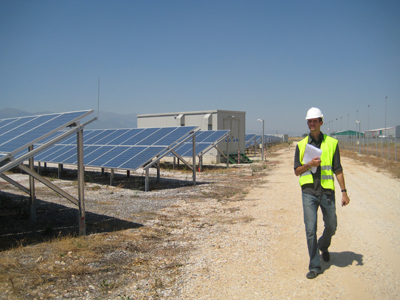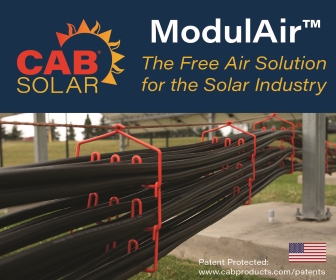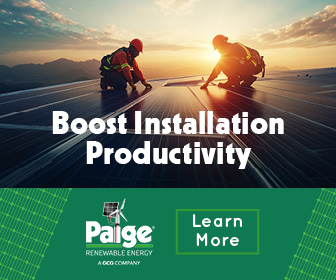Putting Site Safety First: Creating an effective health & safety culture
 There is sometimes a perception within the renewable industry that the construction and implementation of solar photovoltaics (PV) is a simple and straightforward procedure, posing little to no risk of harm. After all, working at height isn’t as much of an issue, especially in comparison to wind turbines, which are lifted and assembled dozens if not over a hundred meters off the ground. And, chemicals aren’t much of a concern in comparison to biofuels or even certain waste-to-energy projects.
There is sometimes a perception within the renewable industry that the construction and implementation of solar photovoltaics (PV) is a simple and straightforward procedure, posing little to no risk of harm. After all, working at height isn’t as much of an issue, especially in comparison to wind turbines, which are lifted and assembled dozens if not over a hundred meters off the ground. And, chemicals aren’t much of a concern in comparison to biofuels or even certain waste-to-energy projects.
Much like any industry, however, effective occupational health and safety management is integral to delivering safe solar power projects that are on time and on budget. “Safe” is the key word here. Upon analyzing some of the issues and risks associated with the development, construction, and maintenance of solar projects, it’s possible to identify, eliminate, and control potential site hazards.
The main areas to consider when planning for occupational health and safety on a solar power project, include: planning; competency; cooperation; coordination; communication; risk management; and the overall health and safety culture.
To understand the risks involved in the development and construction of a solar power project, let’s first look at the importance of risk management.
Managing risk
Solar PV sites, as with all renewable construction sites, expose people to significant risks that are caused by some fairly routine project activities and hazards—such as the use of a mobile plant, lifting operations, as well as the existence of low-, medium-, and high-voltage electrical systems. The difference is merely in terms of scale.
For example, work at a solar plant might involve PV modules or transformers weighing a maximum of two or three tonnes being lifted into place, at a maximum jib height of five meters. On a wind farm, however, lifting a nacelle of more than 80 tonnes can be carried out at a jib height of 80 meters or more.
Although the risk ratings for both lifts in this case would be different due to the loads and distances involved, there’s still a real danger in someone being struck or crushed by a load. The risk of injury is just as possible and significant at a solar site. Moreover, there’s also the additional threat of complacency. As a large proportion of the work done at a solar site is repetitive, recurring actions are more likely to lead to a lack of concentration—and, these are often the times when accidents occur.
Bearing this in mind, contractors should make every attempt to combat repetitive work by employing control measures that include regular breaks and job rotation. Overall, risk management in relation to occupational health and safety management should involve a realistic and balanced approach to assessing the project risks that can have a negative impact on the project. A positive occupational health and safety culture is defined by the ways in which safety itself is managed on a project, and often reflects the attitudes, beliefs, perceptions, and values that employees share in relation to occupational health and safety.
Unfortunately, all too often renewable energy sites reflect the timescales and budgets allocated to them, and the speed and savings that must be attained, rather than the risks and hazards that must be avoided or managed. The onus lands on the developer and the main contractor to establish a site culture of safety first, by implementing such things as the correct signage a jobsite, proper training for workers, safe and efficient tools and equipment, as well as overall safety and emergency guidelines.
The biggest influence on a site culture tends to be the behavior of the managers and supervisors. For example, if the site manager is walking around without a hard hat but the site rules clearly stipulate that one must be worn at all times, then the culture starts to decay because the project manager is not complying with his own set of rules.
To create a site culture that values occupational health and safety, implementation should ideally begin long before a project actually gets started. And, it begins with proper planning.
Effective planning
Often opportunities to properly plan and manage risk are lost during the feasibility, development, and design phases of a project. Again, timelines and budgets can interfere with proper planning.
Nonetheless, effective planning involves two important aspects:
- The development of an effective occupational health and safety management system that reflects the hazards and risks associated with a specific solar project. A robust plan adds structure to a project and ensures a consistent approach.
-
The implementation of a robust risk management process, which is utilized during the design and construction phase of a project, to ensure critical risks are managed. Where unexpected or residual risks occur, documentation and communication should take place to safeguard future contractors or personnel who might similarly be affected. This allows for the ongoing formulation of an up-to-date safety management system.
During the planning phase, the primary goal is to minimize any and all risks to people involved in a project. At the same time, it’s important to decrease any risks to the project environment and the client’s asset. The more time and effort that is invested in the early stages of a project, the greater likelihood of project success without accident or injury.
Ensuring competency
Another important aspect of managing occupational health and safety involves the project personnel. People are integral to the success of any project. If each individual working on a solar power project is to make the maximum occupational health and safety contribution, then the site owners and employers must ensure they are competent to do so.
Competency is based on three key elements:
- Knowledge—of the job, the worksite, the project expectations, the work itself, and the risks involved.
- Training—on how to minimize risks, on how to safely work any required technology and equipment, and on what to do in the case of an emergency; and
- Experience—simply walking out of education or a training course with a full range of knowledge, regardless of a potential project situation is rare if not impossible. Beyond training, industry experience and guidance under a more accomplished mentor is important.
Concentration and a high work standard should be considered mandatory for every solar power project. Perhaps the best adage to consider: “Better safe than sorry.”
Cooperative communication
Communication and cooperation are integrally linked. It’s a lot easier to work together in an efficient manner if expectations are clearly conveyed. And the communication of information is essential to the safe and successful running of a project.
Cooperative coordination between all parties engaged in a solar energy project not only ensures a project runs smoothly and remains on target with its goals, but it also tends to signify that each person involved is aware of their own roles and responsibilities—which is extremely important on a site with various personnel at work and ongoing construction.
For communication to be truly effective, however, it must flow openly in both directions, so that all parties—stakeholders, project owners, developers, and worksite personnel—are openly discussing objectives, challenges, concerns, and conflict.
When tight time scales and budgetary constraints conflict with project development, however, rushed work and poor communication can negatively impact the occupational health and safety measures. Therefore, establishing guidelines for cooperation, coordination, and communication early on, and even before a project begins development is important.
One of the most important communication processes is the site induction, as often this is the initial means of communicating the key information about hazards, processes, and site rules before any work commences. Quite often, developers and contractors find it helpful to develop a procedure that covers all methods of communication including meetings and briefings.
It’s also worth noting that when communicating information to others, there’s a limit to the amount of information an individual can retain and process—current research finds that a person can only hold onto about eight pieces of information at any one time. With companies from different countries sometimes sharing in the stake of certain projects, and foreign workers a possibility at any site, language barriers should also be considered.
To ensure project objectives and site safety measures are implemented and fully comprehended, all communication should be:
- Clear;
- Concise;
- Relevant;
- Understood; and
- Two-way.
There are risks involved in any project, and especially ones that involve construction and energy work. By not planning ahead or by being complacent about the importance of occupational health and safety places all personnel, as well as the project itself, at risk. As such, a solar power project should have the same importance placed on managing risk as any other to ensure the health and safety of all concerned and the overall success of a project.
Paul Taylor is the health and safety manager at SgurrEnergy.
SgurrEnergy
www.sgurrenergy.com
Author: Paul Taylor
Volume: July/August 2014











.png?r=8387)
